Issue Number 21, Summer 2013
Contents
- Fern Hill by Dylan Thomas
- After the Fire by Bill Gainer
- Becoming a Horse by Ross Gay
- Below Isberg Pass by Patti Trimble
- Cherries, 1960 by Susan Kelly-DeWitt
- Cricket by Kathleen Hellen
- Fraser by Catherine Owen
- Heat Wave by Randall Potts
- Hope by Monique Gagnon German
- Landscape Without Bicycle by Katharine Coles
- Letters from the Hinterland #5, Geometric Earth by Raymond Greiner
- Mountain Lion by John Popielaski
- My Father, the Arborist by M.P. Jones
- Passenger Pigeon by Hilary Sideris
- Rubble, Barn Style by Tom Sheehan
- The Call by Karen Terrey
- The Crowded Town by R.S. Stewart
- The End by Andrew Michael Roberts
- The Martian Bureau of Forestry by Ken Poyner
- The Moon Is Backing Away From Us by Linda Benninghoff
- The Pileated Woodpecker by Todd Outcalt
Archives: by Issue | by Author Name

Fern Hill
by Dylan Thomas
(1914-1953)
Thomas published Fern Hill in 1945. In it he recalls his frequent childhood visits to his aunt and uncle’s farm in Llangain, Carmarthenshire, Wales.

Now as I was young and easy under the apple boughs
About the lilting house and happy as the grass was green,
The night above the dingle starry,
Time let me hail and climb
Golden in the heydays of his eyes,
And honoured among wagons I was prince of the
apple towns
And once below a time I lordly had the trees and leaves
Trail with daisies and barley
Down the rivers of the windfall light.
And as I was green and carefree, famous among the barns
About the happy yard and singing as the farm was home,
In the sun that is young once only,
Time let me play and be
Golden in the mercy of his means,
And green and golden I was huntsman and herdsman,
the calves
Sang to my horn, the foxes on the hills barked clear and cold,
And the sabbath rang slowly
In the pebbles of the holy streams.
All the sun long it was running, it was lovely, the hay
Fields high as the house, the tunes from the chimneys, it was air
And playing, lovely and watery
And fire green as grass.
And nightly under the simple stars
As I rode to sleep the owls were bearing the farm away,
All the moon long I heard, blessed among stables, the
nightjars
Flying with the ricks, and the horses
Flashing into the dark.
And then to awake, and the farm, like a wanderer white
With the dew, come back, the cock on his shoulder: it was all
Shining, it was Adam and maiden,
The sky gathered again
And the sun grew round that very day.
So it must have been after the birth of the simple light
In the first, spinning place, the spellbound horses walking warm
Out of the whinnying green stable
On to the fields of praise.
And honoured among foxes and pheasants by the gay house
Under the new made clouds and happy as the heart was long,
In the sun born over and over,
I ran my heedless ways,
My wishes raced through the house high hay
And nothing I cared, at my sky blue trades, that time allows
In all his tuneful turning so few and such morning songs
Before the children green and golden
Follow him out of grace.
Nothing I cared, in the lamb white days, that time would take me
Up to the swallow thronged loft by the shadow of my hand,
In the moon that is always rising,
Nor that riding to sleep
I should hear him fly with the high fields
And wake to the farm forever fled from the childless land.
Oh as I was young and easy in the mercy of his means,
Time held me green and dying
Though I sang in my chains like the sea.
© Dylan Thomas

After the Fire
by Bill Gainer
For more than 30 years Bill has lived and worked in the Deer Creek, South Yuba and Bear River watersheds of Northern California.

we'll sweep the ash,
wash the dogs,
water down the porch,
think about church -
won't go,
the kids and the neighbors -
won't call.
We'll probably throw
a bale of hay out for the deer,
some birdseed
for the wild ones,
wonder when they're going
to get the power back up
and wait for the smoke to settle.
We'll think about how quiet it gets
without leaves...
it's always quiet
without leaves....
© Bill Gainer
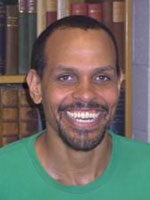
Becoming a Horse
by Ross Gay
Ross lives in the Lower East Fork White Watershed.

It was dragging my hands along its belly,
loosing the bit and wiping the spit
from its mouth that made me
a snatch of grass in the thing’s maw,
a fly tasting its ear. It was
touching my nose to his that made me know
the clover’s bloom, my wet eye to his that
made me know the long field’s secrets.
But it was putting my heart to the horse’s that made
me know
the sorrow of horses. Made me
forsake my thumbs for the sheen of unshod hooves.
And in this way drop my torches.
And in this way drop my knives.
Feel the small song in my chest
swell and my coast glisten and twitch.
And my face grow long.
And these words cast off, at last,
for the slow honest tongue of horses.
© Ross Gay
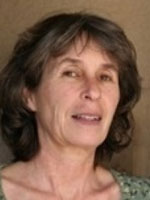
Below Isberg Pass
by Patti Trimble
Patti lives on the edges of two watersheds: In California near San Francisco Bay, she often walks from her house to the sludgy tidal slough known as the Petaluma River. In Sicily (where water flows mostly underground) she lives close to Fonte Aretusa, a freshwater spring bubbling up a few feet from the Mediterranean.

Each summer I imagine myself a voyager
to the unknown, my high meadow wilderness
some beloved green sea, my heart
a gyroscope that spins to the high view
where river runs to cloud.
I must go there in those brief and fragile months.
I must memorize flowers that hang from threads,
columbine, cinquefoil, or the tiniest white daisies.
But where I once thought the sky trembled
and boulder shivered for every god in need of a home,
I now believe it shakes in fear of me
and see behind me deepening trenches
across this Earth I meant to love.
© Patti Trimble
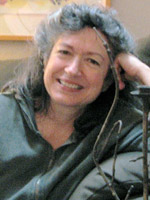
Cherries, 1960
by Susan Kelly-DeWitt
Susan lives in the Lower Sacramento Watershed, about two miles from where the Sacramento and American Rivers meet.

We waded knee-deep through quaking grass and brome into the orchard’s shade
to pick the dark sweet Bings that dyed our cheeks and lips and chins in cherry.
A man with an oilcloth tablecloth and a sign “Bing Cherries $1 a Bucket” gawked
after us and grinned, as if to say, cherries—that’s all there is to happiness.
The Buttes were to our west and to our east, the hazy Sierras. We did not know our father
would be buried between them a few years later, or that the orchard would be sold off, bulldozed.
We stuffed our mouths recklessly, full of ripe fruit and easy laughter,
as if there would always be plenty more where these came from.
© Susan Kelly-DeWitt
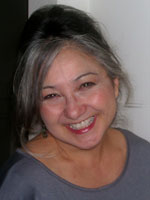
Cricket
by Kathleen Hellen
Kathleen lives in the Jones Falls Watershed where sewage has spilled into its tributaries for decades. The Watershed comprises 58 square miles of urban and suburban Baltimore.

A stealthy dark and quiet
the basement is its own assassin’s night
but for the rumble—
the sump pump rains have wildly flushed
and this
darling pest, his
boisterous vibrations
Cricket in a paddy
in the northeast of the city
digging tunnels
when suddenly he quits
as if danger to the washer could be heard
in the shuffling of my slippers to the load
Danger to the hammers and the mower
Danger to the reign of the blower
Silence studies distance
Silence studies wherewithal and waits
© Kathleen Hellen

Fraser
by Catherine Owen
Catherine lives on the edge of the Lower Fraser Estuary where it runs into Vancouver, BC, down from Hope. She regularly walks the trails by the water where one can encounter otters, bald eagles, herons and the occasional coyote.

Off every wharf, the thin filaments of fishing lines,
hopeful arches
Into unharboured waters & in eel grass alongside the
path, on the edge of gyprock
Where rusted re-bar sticks sharply from the mud, they
crouch, men with conical hats,
Pouches of flies. The river is acidic. Tugs & speedboats
rip lines in its narrow chute
Down Marine to the ship yard, the mill. Salmon &
sturgeon have dimmed, gone out.
Nothing is ever pulled up, reeled towards them but a
kind of silence; they must hush
With this waiting, go home with the world they made us,
absent, on their hooks.
© Catherine Owen

Heat Wave
by Randall Potts
Randall lives in the Northbrae district of Berkeley, California, which was occupied by the Huichin band of the Ohlone for tens of thousands of years. Their acorn-grinding pits still remain in the rhyolite rock formations at Indian Rock Park, about a block from his home.

Since each day’s heat is exemplary
Record books are useless diaries—
It’s just getting hotter.
Attic fan thumps the wall
Warped windows rattle—
They’re just getting louder.
Unusual questions arise.
Can a Year have no seasons?
Will tomorrow burn down?
Can we outrun the lengthening heat?
© Randall Potts

Hope
by Monique Gagnon German
Monique lives along the Susquehanna River Basin in south-central Pennsylvania, writing poems above the Codorus Creek watershed.

It is a tender thing,
this morning
with the heat
not yet intense
but building,
the air, cool
at the ground
lifting water
up as beads
on stilts of grass,
miniscule
diamonds
and pearls
free from strings
and necks.
Even the furled
brown fists
of the ferns
in the garden
seem to relax a bit
in anticipation
of some new thing,
swelling in the places
they are still green.
© Monique Gagnon German

Landscape Without Bicycle
by Katharine Coles
Katharine lives atop a foothill abutting City Creek Canyon, one of Salt Lake City's six protected watershed canyons. She and her husband share space (and their garden) with mule deer, coyotes, raccoons, squirrels, various hawks and other birds, weasels, wild turkeys, foxes, and the occasional moose or bobcat.

A two-wheeler wouldn’t get you anywhere
Here, though one afternoon
An oceanographer ran the eighth-mile
Mud road from Bio to Terra Lab
And back one hundred times. Mired
Right up to its pedals, it wouldn’t even
Cheer the place up. For that,
We have huge containers lined
Like lively teeth outside my window—
Yellow, red, blue, storing all
We throw away. A view of the dump
In primary colors. When the ship comes
Logistics will load them, flying
Them by crane dock to deck
While I follow over
The gangplank. Together, we’ll cross
Rough waters to a country where
I put my cast-offs out of sight
And mind. What happened to my childhood
Schwinn hand-me-down
Decked with streamers and a thumb-bell? Don’t
Consider what
I’ve put behind me. Beyond us, mountains
Keep themselves, and sky.
© Katharine Coles
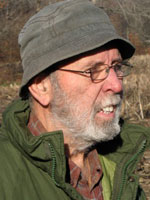
Letters from the Hinterland #5, Geometric Earth
by Raymond Greiner
Raymond lives with his canine companions Orion and Venus on 14 acres of remote forested and pasture land about three miles from the hamlet of Paragon, Indiana, in a cabin about 500 yards from the little-traveled road.

Today I have been thinking about geometric patterns and shapes and their consequences, the obvious, the less obvious, and those about which I feel quite skeptical. I’m thinking about geometry’s vastness and profuse influential melding with Earth’s functions and living forms, the way patterns and shapes release visual pulsations activating a myriad of energizing forces which directly affect all beings.
Geometric designs are prevalent in nature. Some display distinct symmetrical perfection; others are called fractals, which are formed by fragmentation, splitting into parts creating reduced-size copies of the original form, a process call self-similarity which can vary in degrees of duplication, often abstract in shape and size, some forming less accurate duplications while others are more exact. Examples of fractals in nature include clouds, river networks, fault lines, mountain ranges, snowflakes, lightning, cauliflower, broccoli, systems of blood vessels, and ocean waves. Even coastlines may be loosely considered fractals in nature. Trees and ferns also are clear examples of fractals. Artists are inspired by fractals; the renowned abstract artist Jackson Pollack often displayed fractals in his works.
I see spider webs daily in summer. A tiny creature on its mission of survival creates these devices. A single spider will often construct five webs each day, and then eat its web after it has served its purpose in order to ingest protein, creating material for its next set of webs. These webs are images of beauty, especially when the morning sun strikes them; they glisten, revealing geometric design perfection.
Honey bees are master craftsmen; their cells are perfect hexagons, constructed of micro-tolerances with each cell positioned at a 13-degree list to prevent the honey from tipping out prior to sealing it with wax. These tiny hexagon cells may vary in size. Gauged upon the space allotted to construct the entire comb, the size variations are engineered to exactly accommodate the number of cells within the comb’s available construction site. Size variation is more common in wild hives because in manufactured hives the allotted construction space is uniform. Honey bees reflect evolutionary intelligence, which functions throughout nature.
Geometry is vividly displayed throughout the earth in special applications, often in a direct relationship with human interaction. Some geometric forms and structures are linked to metaphysical speculation, mysteries as the specifics of their origins are unknown. The Great Pyramids are examples; the how and why of their construction is a source of endless debate, and there are theories as extreme as divine intervention. It’s a fascination that the Egyptians constructed these large, complex geometric structures applying a distinct knowledgeable of geometry.
The Romans struggled with geometry, (which was problematic because of the difficulties associated with the application of Roman numerals to solve complex calculations) and were probably incapable of constructing such large, precise pyramid structures. As a result of the Roman’s inability to assimilate the principles of geometry, the science stagnated for 2000 years, from the time of the Egyptian pyramid construction.
Finally, the Greek mathematician Euclid (325-265) offered the world the first clear understanding of Geometry. Euclid was an intense student of Egyptian history and also lived much of his adult life in Alexandria, Egypt, so it is speculated that his ability to absorb and understand the principles of geometry was connected to his Egyptian interests. Greece and Egypt had a long period of trade and cultural connection, which may also have contributed.
The base measurements on the Giza pyramid, the largest one, are within six-inch tolerances point to point; modern buildings of lesser dimension cannot hold such tolerances. The exactness of this large, complex structure continues to perplex modern architects. It certainly does cause wonder.
The intricate design of many of nature’s critters is another source of mystery and fascination. The common box turtle displays unique and beautiful geometric markings, extending onto its shell’s lower flange. Whenever I discover one of these turtles, I always pause to examine these patterns. Such perfection. The chambered nautilus also characterizes living geometry with its expanding spiral of distinct markings all along the shell’s exterior, growing larger as the inhabitant of the shell moves to the next chamber, a true wonder of the deep. And if the shell is cut in half, it’s revealed that the chambers are equally spaced in a perfect equiangular spiral!
Flowers and plants are directly connected to soil, water and sunlight, displaying distinct and uniform geometric patterns, flourishing with color that attracts pollinators, a great bonding of sun, earth and organisms in rhythmical, omnipresent symmetry.
Geometric wonders are captivating, unfolding with infinite variety of shape and scale. Geometry and nature are meshed, moving forward in unison, emulating the geometric universe. The abundance of these observations offers continuing proof that all life forms on our planet, and likely on other planets, are wholly fused, ever evolving in a vast variety of patterns and shapes. Geometric earth.
“The goal in life is to make your heartbeat match the beat of the Universe. To match your nature with Nature.”
– Joseph Campbell
© Raymond Greiner

Mountain Lion
by John Popielaski
John lives in the Connecticut River Watershed, just down the road from Meshomasic State Forest.

There have been rumors,
unconfirmed reports,
that you, long absent,
have returned.
The failed farms yielded
to the seedlings,
and the forests, first felled
centuries ago,
came back. It’s not
the range historically
your line is used to,
but there’s game
and people do not wander
too far off the trails.
There will be trouble
if you’re spotted, though.
The camera-phone, the modern-day
equivalent of the pitchfork,
will be brandished,
and you’ll find returning
to the fringes difficult.
But there are those
who root for you
and understand you only know
predation, gliding
like an old fear through the woods
in which the civic-minded
will leave poison and take care
their hands do not get injured
setting the excruciating traps.
© John Popielaski
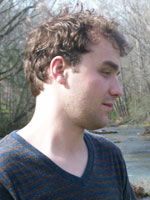
My Father, the Arborist
by M.P. Jones
M.P. lives in Gainesville, Florida's urban Possum Creek watershed, where he works, writes, and raises backyard chickens.

My father never liked
cutting the old ones down,
but there was always some
century-old Water Oak
threatening the new renovations
on the quad or cracking
a fresh concrete foundation.
He took me out summers
and let the humid air wick away
any desire to follow his footsteps.
My father never let me touch a saw,
as if to keep the blood from my hands,
but he let me watch, and I learned
there is a note a tree makes
when the chainsaw pierces the last ringlet,
chewing the marrow of loamy heartwood—
the sound of letting go, and
sometimes the great trunk turns,
waving branches & crashes to earth,
making a sound it cannot hear.
My father was not an evil man; he was
like other men, just trying to get by.
where he knelt, mumbled
if I don’t,
someone will.
Forthcoming in the author's book, Live at Lethe (Sweatshop Publications, 2013)
© M.P. Jones
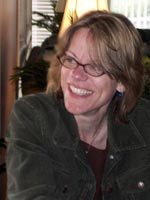
Passenger Pigeon
by Hilary Sideris
Hilary lives in Brooklyn, near Prospect Park, which lies on a ridge of terminal moraine that used to be under a sheet of ice one thousand feet thick.

Once so numerous on earth,
colossal flocks blocked out
the sun, this slender racer,
clocking sixty miles per hour,
fed on seeds, laid eggs in forests
of savage undergrowth.
Under nests we set fires,
stuffed our pillows with her
plumage, fed her flesh to pigs.
Last seen in the Cincinnati Zoo,
her body let her soul go
on the eve of the Great War.
© Hilary Sideris
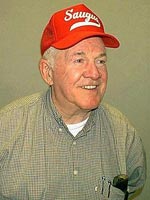
Rubble, Barn Style
by Tom Sheehan
Tom lives in a house built in 1742 about 200 feet from the Saugus River in the Saugus River Watershed bounding 900 acres of the Rumney Salt Marsh and 450 acres of a wetland, Reedy Meadows.

Dust from last century
settles deeper, tattles
tales when jammed open
by a heavy broom, a toe
dragged through lifelines,
the demise of contours.
Barns this size, kneed
in the groin by January
storms, wet coughs of April,
August retreats from fire
when gummed capillaries
draw back to old dowsing
grounds, always show age,
the way blue ribbons are worn.
Sun, even a dish-bright moon,
occasionally a star if you’re
still in your tracks, breathless,
hoist themselves where nails
also fell to mines of earth.
But it is here that iron
and wood trade final secrets.
Under rust’s thickest scab
the metal keeps its black shine;
abrade it with rock and stone
and the line of light leaps out,
like the flesh of wood flashes
its white mysteries orbiting
marks of lunar growth.
A mole tortures underground,
a host of bats above like gloves
hang to dry in the dim light,
and in twisted byroads
and blossoming paths the termites,
carpenter ants and dust beetles
chew the cud of oak sills, risers
an ash released to two-hand saw,
and green pine checked, stippled,
full of eyes where knots let go.
Square nails, blunt as cigars,
suddenly toothless, a century
of shivering taking its toll,
shake free as slow as worms.
For all the standing still
there’s action, warming, aging,
the bowing of an old barn,
ultimate genuflection.
© Tom Sheehan
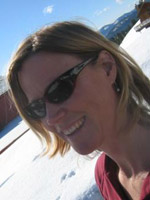
The Call
by Karen Terrey
Karen lives in Truckee, California, within sight of the Truckee River, part of the Lake Tahoe Watershed. The river runs about 120 miles from its source, Lake Tahoe, to its end in Pyramid Lake, just north of Fernley, Nevada.

Crouch in that still meadow, narrow rush
between rising hills, open water,
small eggs in nests pursed into willows.
Strange red-tipped cranes gurgle their warning
in grass-bent sunlight.
Mid-stream, broken railroad ties
settle further a private angle
like a long marriage. Far from home,
the cranes appear as tall
as you. Stiff with caution, the pair
just dropped from their sky into this unknown refuge.
If you surprise them in the wet sedge,
stick legs bright, toes graceful -
question everything.
Among the edging pines, their calls weave,
falling through tall necks like water
sifting under the broken bridge, slow
and clear to its mucky bottom.
Love. You know how.
© Karen Terrey
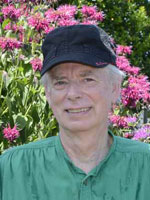
The Crowded Town
by R.S. Stewart
R.S. lives near both the Middle Willamette Watershed in Marion County, Oregon, and Silver Falls Park, ancient home to ten waterfalls.

The crowded town was once a place
Of pebbles and applause,
An acre where the only crowd
Came to the edge of a field
To watch the balloonists balancing their baskets
As beautifully as birds alighting
On their slender and delicate branches.
© R.S. Stewart

The End
by Andrew Michael Roberts
Andrew lives in Portland, Oregon, near the confluence of the Willamette and Columbia Rivers, in the shadow of a dormant volcanic cinder cone named Mt. Tabor.

it was the end of something,
and so we grew sad
according to how much we'd loved it.
now, nothing
but our great variety of sadnesses
and for some
a seed of instinct suggesting
something else
may eventually begin.
Originally published in something has to happen next (University of Iowa Press).
© Andrew Michael Roberts
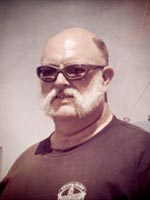
The Martian Bureau of Forestry
by Ken Poyner
Ken and his wife live in a forest of town homes, surrounded by a marcher land of track residences, all held back only by the Naval Base and the terror of the sea. All of this drains through the Lynnhaven-Poquoson watershed - part of the superlative Chesapeake Bay watershed -- to the Chesapeake Bay and the Atlantic Ocean.

This is the easiest job on this planet:
Each day I put on my suit,
Emerge from our communal hole in the ground,
And watch the thin air play tennis
With the dust. I annotate that, today,
Nothing will grow here. I will check again tomorrow.
I go back to my warren, collect
Each month my salary of support-staff company credits.
I listen to our cheaper labor tunneling smooth hollows
Of what some celebrated day will be our arboretum.
I calculate Martian years to Earth years
To determine when I will be eligible for my pension.
© Ken Poyner

The Moon Is Backing Away From Us
by Linda Benninghoff
Linda lives in the Northern Long Island Watershed in back of Caumsett State Park and less than a mile from the Long Island Sound.

The Moon Is Backing Away From Us
-D. Laux
We have not valued the field,
have not taken care of our gardens.
We have drilled for oil
in the white home of the polar bear,
and shot the deer in the park
that abuts our backyard.
The moon is backing away from us,
with her yellow arms
held open. I want to stretch my hands
back to her, but
she does not know me,
or the ruined earth.
© Linda Benninghoff
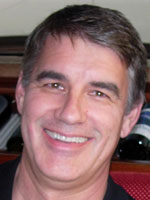
The Pileated Woodpecker
by Todd Outcalt
Todd lives on the White Lick Creek watershed in Brownsburg, Indiana, where he frequently kayaks to work and shares space with beavers, red fox, deer, and plush acreage filled with birds and flowers.

The Spotting
This past spring—on a cool morning with coffee cup in hand—I spied the pileated woodpecker through the dawn mist. Clinging to the trunk of the hackberry tree, the bird was magnificent—long, lean, and crested with a flaming-red plume that exploded against the earth-tone gray of the hackberry bark. Motionless, the bird remained in its vertical hold for long minutes, a kind of snapshot, a brush-stroke of color amid the ripe green leaves of spring. Suddenly, the bird released and, instead of falling, rose majestically through a canopy of maple, buckeye and oak until it disappeared against the backdrop of morning sky.
The Deck Feeder
Another morning, days later, I am reunited with the woodpecker as it perches on a rotting squirrel -feeder that the previous home owners had nailed to the trunk of the hackberry. This is an odd picture, as I have never seen a pileated searching for food in a feeder. But the bird pauses, as if studying the situation, and then offers a few faint-hearted taps upon the rotted wood. There are no grubs in the pores of the feeder and the bird’s attention is suddenly wrested away by a harsh gush of wind that stirs the leaves. As the bird wings away, I stand at the window and wonder: where does the woodpecker find comfort, and where does it go for solace from the storm?
The Siding
It is mid June. Striding along the path near the creek I hear the echo of a rap-rap-rap on the side of the house. I locate a clear vista and peer up onto the eastern face of our home. There, clinging to the house, is the pileated woodpecker drilling its bill into my wood siding. Even from my distance, I can see that the bird has culled a silver-dollar-sized hole in the pale, sun-bleached siding. I flinch at the thought, but am then suddenly moved by the awe of the hunt. The giant crest of the pileated bobs and shudders as it feeds on the miniscule. The waters of the creek slip silently along behind me and, for a moment, my attention is wrested away by a small yellow dot of flower that is peeking through the dirt along the hardened path where I am walking. When I look up again, the woodpecker is gone.
The Silence
I consider the woodpecker one afternoon in early July while I am mowing the yard. Days have passed without a sighting. Would anyone dare to assume a woodpecker’s joy?
The Return
Mid July, I am reunited with the pileated woodpecker. It clings, as before, to the bark of the hackberry on a summer morning. As the bird angles its head away from me, I can see that its beak is disproportionally long—a kind of curved straw. The beak is the lifeblood of the pileated. The beak is its hope. With wings flattened against its slender body, suddenly the woodpecker opens like a trap door and, after a moment’s descent, rises like a breath on the summer air and is gone.
The Last Sighting
As I amble up the lawn, firewood in hand, suddenly the woodpecker appears in a clearing—a kind of spark, a flame flush against the verdant background of the trees. Red against green, I cannot miss the bird as it steps, talon-prone, inch by inch up the side of a towering sycamore. Weak-armed, I stoop to deposit the firewood on the lawn and gaze up into the summer sky to study the bird again. It is toying with me. Showing off as children do. Or so it seems. The pileated shakes its plume at me—a wisp of blood-red feathers, fine as powder, and I can see the ends dancing in the early August heat. The woodpecker pauses. We stare at each other. Our meeting ends when the bird issues a guttural cry and sails across the creek into a deep morass of maple and walnut.
The Death
Carrying the morning newspaper under my arm, I discover the pileated woodpecker on the gravel driveway beneath the large bow window of my home office. It is dead. Perhaps in early morning or the night before, it had flown-into the reflection of the window and broken its neck. I kneel, set aside the newspaper, and cusp the bird in my hands. It is still warm. I marvel at the size of the bird, perhaps eighteen inches in length, and as the morning light crosshatches the trees I note that the bird’s feathers are a myriad of color, a rainbow embedded in the darker navy-black of the body, and the distinguishing red plume ripe with hints of white and yellow. The eyes are closed, and the rims dotted with curious dots of raised skin. The talons are coal black, sharp as needles. I wrap the bird in a section of newspaper classifieds and wonder how a woodpecker experiences its own color, its own existence? I carry the bird down to the creek accompanied by the dirge of songbirds and the rustling of mid-August leaves announcing the end of summer. I remove my shoes and wade into the creek. The water is effervescent. I bend over and hold out the section of newspaper containing the pileated woodpecker.
The Release
The hardest part is the letting go.
© Todd Outcalt